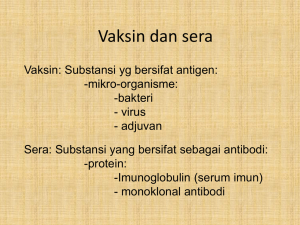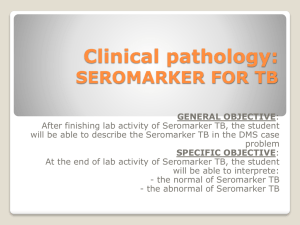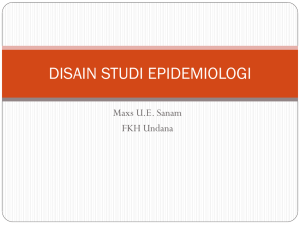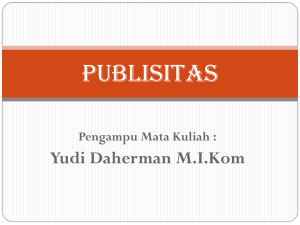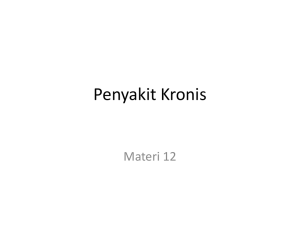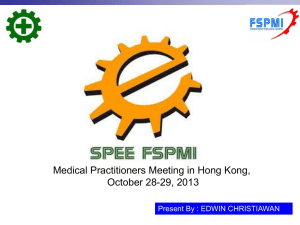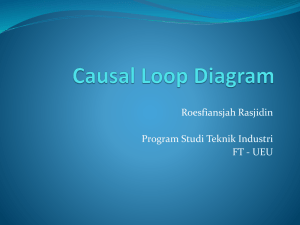Kuliah Pakar Life Expectancy
advertisement
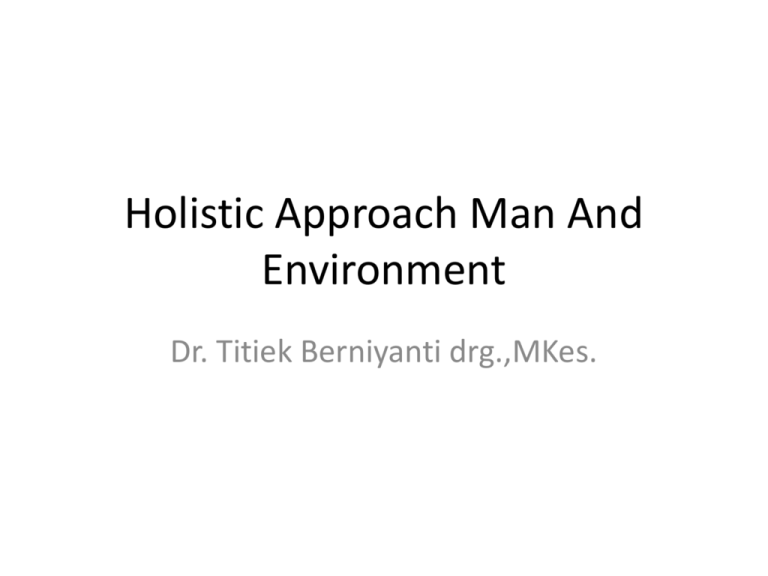
Holistic Approach Man And Environment Dr. Titiek Berniyanti drg.,MKes. Tujuan Instruksional • Kompetensi Umum: At the end of the third semester the student should be able to conceptualize environment to be an important factor in the interaction of agent and Host in the epidemiological or ecological triad, conceptualize the physical, biological and psychosocial environment and understand their impact on health, and be expected to raise awareness about critical need for a more holistic understanding of the links between ecosystem wellbeing and Human health. Objectives • • • • • • • • Bloodborne Pathogens Statistics Injury Process Infection Control Personal Protective Equipment Water lines and Water Quality General Safety (x-ray, laser, physical, drills) Pandemic Preparedness Life Expectancy Determined by: • Genetics • Environment Air Water Food / Nutrition Shelter Multiple Causation Theory • “ Disease development does not rest on a single cause.” There are 3 models to explain the theory: 1. The Wheel 2. The Web 3. The Ecologic Triad Ecological Triad • The three elements of the triad interact with one another in an attempt to maintain an equilibrium. • Any major change in any one of the factors may bring about a disturbance in the equilibrium provoking the appearance of a health problem. SEGITIGA EPIDEMIOLOGI MUTAKHIR Segitiga epidemiologi dalam penyakit menular merupakan dasar dan landasan untuk semua bidang epidemiologi Penyakit infeksi tidak lagi menjadi penyebab utama kematian di negara industri diperlukan Model Segitiga Epidemiologi Mutakhir mencakup semua aspek dalam model penyakit menular dapat dipakai bersama penyebab kematian, kondisi, gangguan, defek dan kematian saat ini dapat mencerminkan penyebab penyakit dan kondisi saat ini Perlu diperhitungkan Perilaku, faktor-faktor gaya hidup,penyebab di lingkungan, unsur ekologi, faktor fisik, penyakit kronis Agens • Agens adalah penyebab penyakit. Bakteri, virus, parasit, jamur atau kapang ditemukan sebagai penyebab penyakit infeksius. Pada penyakit, kondisi ketidak mampuan, cedera atau kematian lain, agens dapat berupa faktor kimia seperti pelarut atau solven, faktor fisik seperti radiasi atau panas, defisiensi Gizi, atau beberapa substansi lain seperti racun ular berbisa. Satu atau beberapa agens dapat berkontribusi dalam satu penyakit. Penjamu • Penjamu adalah organisme, biasanya manusia atau hewan yang menjadi persinggahan penyakit.Penjamu bisa terkena atau tidak terkena penyakit. a.Penjamu memberikan tempat dan kehidup an pada suatu patogen (Mikroorganisme penyebab penyakit atau substansi terkait lainnya. b.Tingkat imunitas, susunan genetik, tingkat pajanan, status kesehatan dan kebugaran tubuh penjamu dapat menentukan efek yang ditimbulkan organisme penyakit terhadap tubuh. Penjamu c. Kondisi tubuh penjamu dan kemampuan organisme untuk menerima lingkungan yang baru juga merupakan penentu, karena beberapa organisme hanya dapat tumbuh pada keadaan yang ideal dan terbatas. Contohnya banyak organisme penyakit infeksius yang hanya bisa Hidup dalam rentang tubuh yang sempit. Lingkungan • Lingkungan adalah segala sesuatu yang mengelilingi kita dan juga kondisi luar manusia atau hewan yang menyebabkan atau memungkinkan penularan penyakit. Faktor-faktor lingkungan dapat mencakup: Aspek biologis Sosial, Budaya Aspek Fisik lingkungan Sekitar tempat hidup organisme dan efek dari lingkungan terhadap organisme Holistic approach man and environment G:\S3A1339D005 (D)Baru\BACKUP 22\BackUp My Documens\M.OMMY 310106\Kuliaah\Kuliah S1 2007\HOLISTIC APPROACH MAN AND ENVIRONMENT.mmap1 Mikroba dan timbulnya penyakit - Patogenisitas - Virulensi - Infeksi Patogenisitas :kemampuan mikroba untuk menimbulkan penyakit.(mikroba patogen) Virulensi : derajat kemampuan mikroba untuk menyebabkan infeksi,yg. Dinyatakan dengan jumlah mikroorganisme atau mikrogram toksin. Infeksi :kemampuan mikroba untuk berpenetra si ke jaringan mengatasi pertahanan tubuh host (invasi),berkembangbiak dan menyebar----gejala penyakit • Bloodborne Pathogens OSHA 1910.1030 Definition: Any pathogenic microorganism that is present in human blood or other potentially infectious materials (OPIM) and can infect and cause disease in persons who are exposed to blood containing the pathogen. Bloodborne Pathogens Examples of bloodborne pathogens: HIV HBV HCV T. pallidum Herpes M. Virus tuberculosis (typically an aerosol hazard) Human T-lymphotropic Virus Type I (HTLV-I) Bloodborne Pathogens Examples of body fluids that can potentially carry the HIV and HBV viruses: Blood Semen and vaginal secretions Saliva involved in dental procedures Synovial fluids Cerebrospinal fluid human tissue and cell cultures All body fluids containing blood Transmission Mucous membrane contact - example splash to the eyes, nose and/or mouth. Percutaneous inoculation - misuse of sharps (broken glass, needles, etc.) Exposure to broken/damaged skin - the risk increases, if contact involves a large area of the skin or if contact is prolonged. Risk also increases with increased HIV titer levels in the source patient’s blood. Methylmercury : In the Body • Methylmercury exposure in humans is from consumption of fish, marine mammals, and crustaceans • 95% of fish-derived methylmercury is absorbed into the gastrointestinal tract and distributed throughout the body – Highest in concentration in hair www.mercury.utah.gov/images/health_effects.jpg Minamata Disease in the Nervous System Areas in red show areas typically affected by the presence of methylmercury in the system . The lesions show characteristic signs and symptoms in Minamata disease. 1. Gait disturbance, loss of balance (ataxia), speech disturbance (Dysarthria) 2. Sight disturbance of peripheral areas in the visual fields (constriction of visual fields) 3. Stereo anesthesia (Disturbance of sensation) 4. Muscle weakness, muscle cramp (disturbance of movement) 5. Hardness of hearing (hearing disturbance) 6. Disturbance of sense of pain, touch or temperature (Disturbance of sensation) National institute of Minamata Disease Archives Symptoms of the Disease • Mild – – – – Ataxia Muscle weakness Narrowed field of vision Hearing and speech damage • Severe cases cause – – – – Insanity Paralysis Coma Death W. Eugene Smith Tomoko Uemura in Her Bath Minamata, 1972 More Symptoms • A significant effect of Minamata is the onset of symptoms similar to those of cerebral palsy • Fetal Minamata Disease – A pregnant mother ingests toxic fish and the methylmercury concetrates inside the placenta. – Harms the fetus while the mother is relatively unaffected http://picasaweb.google.com/jazzyv0504/SA KURA#5065603192708172658 These are all children with congenital (fetal) Minamata Disease due to intrauterine methyl mercury poisoning (Harda 1986). Mercury: The Basics • Mercury (Hg) is the only metal that is liquid at room temperature. It melts at 38.9oC and boils at 356.6oC. • Mercury conducts electricity, expands uniformly with temperature and easily forms alloys with other metals (called amalgams). – For these reasons, it is used in many products found in homes and schools. Mercury Chemistry • Mercury exists in three oxidation states: – Hg0 (elemental mercury). – Hg22+ (mercurous). – Hg2+ (mercuric). • Mercurous and mercuric form numerous inorganic and organic chemical compounds. – Organic forms of mercury, especially methyl mercury, CH3Hg(II)X, where “X” is a ligand (typically Cl- or OH-) are the most toxic forms. Questions???
